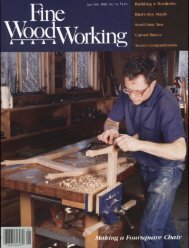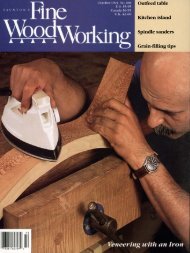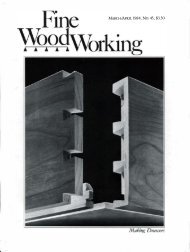Shaping with a Router - MetosExpo - Free
Shaping with a Router - MetosExpo - Free
Shaping with a Router - MetosExpo - Free
Create successful ePaper yourself
Turn your PDF publications into a flip-book with our unique Google optimized e-Paper software.
Paulownia<br />
A transplanted hardwood<br />
that grows like a weed<br />
and works like a dream<br />
by John H. Melhuish, Jr.<br />
P<br />
aulownia, a light-colored hardwood revered for centuries by<br />
Japanese craftsmen because of its workability and beauty,<br />
may someday be the wood of choice for many American<br />
woodworkers and an economic boon for loggers in the Southeast.<br />
Not bad for a u-ee that apparently slipped into the United States<br />
accidentally, in the form of seeds used for packing material.<br />
I fi rst became interested in paulownia wood while working for<br />
the U.S. Forest Service on projects to reclaim land that had been<br />
strip-mined. Loggers and environmentalists were enthusiastic<br />
about the paulownia development in mined-out areas. The trees<br />
grow at an astounding rate, from seed to 10-ft.-tall in six months<br />
(see the inset photo at right), and they grow best in areas <strong>with</strong><br />
poor-quality soil. I, along <strong>with</strong> other researchers, feel that it is impOl-tam<br />
to find good uses for the lumber once the trees have outgrown<br />
d1eir usefulness as soil stabilizers on the strip-mined lands.<br />
Because few American craftsmen have worked <strong>with</strong> d1e wood, I<br />
asked some local woodworkers to try it. You can see some of their<br />
results in the photos on p. 51. So far the results of our early woodworking<br />
experiments have been promising.<br />
A stable wood <strong>with</strong> a long tradition<br />
Paulownia is a lightweight but very strong, very stable wood d1at's<br />
easily worked <strong>with</strong> sharp tools. It has a satiny surface d1at stains<br />
and finishes very well and an open grain that resembles oak or ash<br />
(see the bottom left photo on p. 51). The color of the wood itself<br />
varies according to where d1e trees grow and when they are har-<br />
Paulownia trees are a miracle<br />
of growth. Even in areas<br />
<strong>with</strong> poor soi4 the trees can<br />
grow to be nearly 60 ft. tall,<br />
like the one shown in the<br />
photo above, in a relatively<br />
short time. You can gauge this<br />
growth by the inset photo,<br />
which shows a woman standing<br />
next to a one-year-old<br />
tree. Despite this rapid growth,<br />
the wood is easy to dry and<br />
can be worked <strong>with</strong>in a few<br />
weeks of harvesting.<br />
Dick Top photo: Burrows; insel photo: John Melhuish<br />
March/April 1992 49

















